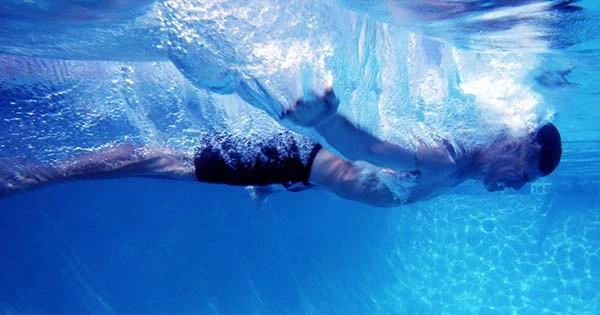Doing a belly flop into the water can hurt, as anyone who’s ever been slightly tipsy by a pool, peered up at a diving board, and thought to themself, “I’ve seen the Olympics, it doesn’t look that hard,” can tell you. But have you ever questioned why this is the case? Grab some arnica gel and a cup of coffee, because the solution involves more experimental physics and engineering than you might think.
According to Daniel Harris, assistant professor at Brown University’s School of Engineering and main researcher in a recent article on belly flop dynamics, the theory of smashing tum-first into a pool is not that complicated. It’s straightforward Newtonian physics: “All of a sudden, the water has to accelerate in order to catch up to the speed of what’s falling through the air,” he explained in a statement. “When this happens, that large reaction force is sent back to whatever’s doing the impacting, leading to that signature slam.”

This simplicity, like the flop itself, is followed by an unavoidable pain. “Most of the work that’s been done in this space looks at rigid bodies slamming into the water, whose overall shape doesn’t really change or move in response to the impact,” says Harris. “The questions that arise are: ‘What if the object that is impacting is flexible so that when it feels the force, it can either change shape or deform?'” How does this affect the physics and, more significantly, the forces felt on these structures?”
The issue is that the basic explanation works only if you’re incredibly hefty. Humans, outside of Marvel movies, have a touch of give around the stomach – and that little real-world element, it turns out, can have some confusing repercussions on the physics.
“Contrary to conventional intuition, we find that ‘softening’ the impactor does not always reduce the peak impact force,” according to the research report. As a matter of fact, it “may also increase the force as compared with a fully rigid counterpart.”
So, how do you research the science of belly flops? Unfortunately, the answer is more “repeated experimentation based on painstaking mathematical modeling” than “massive intramural pool party.” The scientists filmed a cylindrical mass being dropped into the water and analyzed various consequences on the body’s structural stress using high-speed camera equipment and a sophisticated sensor system.
So far, so conventional – but what distinguished Harris and his team’s studies from many others was the addition of a soft impactor to the end of the cylinder via a system of flexible springs. The springs should, in theory, cushion the impact of the bulk by distributing the load over a longer period of time, according to John Antolik, who led the study with Harris.
“The structure is vibrating back and forth due to the violent impact,” Harris added. “So we were getting readings from both the impact of hitting the fluid and an oscillation because the structure is shaking itself.”
In other words, a more flexible flopper may result in a harsher impact rather than a gentler one. So, what’s the deal?
The team learned that the key is in the springs – and getting it properly is a hard job. If the system is too rigid, the impact will not be sufficiently absorbed; if it is too soft, more vibrations will be introduced into the system, increasing the overall force.
While the outcome may be of interest to fathers on vacation, it is perhaps more exciting for the military and undersea researchers. Outside of poolside competitions, military and marine engineering frequently need structures that can withstand high-impact air-to-water slamming pressures, which is why the research was partially financed by the Office of military Research and the Naval Undersea Warfare Center.
Despite the high-tech nature of the conclusion, it appears that nature may have solved the problem long ago – and certainly, Harris and Antolik’s next steps are inspired by the beautiful landings of certain diving birds.
















